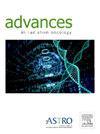基于磁共振成像的妇科癌症风险器官分割的领域自适应和每分引导深度学习框架
IF 2.2
Q3 ONCOLOGY
引用次数: 0
摘要
磁共振成像与放射治疗(RT)治疗的集成需要自动分割算法,以实现快速和准确的自适应干预,特别是在磁共振成像集成线性加速器(MR-linac或MRL)治疗系统中。然而,数据的稀缺性阻碍了这些模型的训练。本研究旨在通过开发一个合成的MRL辅助深度学习框架来解决这一缺点,以建立MRL图像上危险器官分割的稳健基线,并在适应性RT治疗期间实现自动描绘的域适应。方法和材料我们使用回顾性数据集,包括158名诊断为各种妇科癌症的患者,他们接受了计算机断层扫描以制定RT计划,25名患者接受了t2加权mri扫描以进行模型微调、适应和评估。提出了一种基于补丁的循环一致生成对抗网络,用于从计算机断层扫描数据合成核磁共振成像图像。随后,训练一个域自适应分割网络,在获得的MRL图像上分割出6个有风险的器官。此外,我们采用每分数适应,以提高解剖一致性的指导下,个别患者的先前治疗分数。通过定量评估和盲法读者评估来确定轮廓接受率。结果合成的磁共振成像辅助模型提高了MRL图像的危险器官分割精度,其分割轮廓具有较高的解剖保真度。两名放射肿瘤学家报告了适应后治疗计划的轮廓接受率为100%和98%。这个新的框架有望弥合计算机断层扫描和磁共振成像数据库之间的语义差距,潜在地促进适应性RT治疗,减少治疗时间和临床医生的负担。该框架的应用范围可以扩展到妇科和盆腔癌以外。本文章由计算机程序翻译,如有差异,请以英文原文为准。
Domain-Adaptive and Per-Fraction Guided Deep Learning Framework for Magnetic Resonance Imaging-Based Segmentation of Organs at Risk in Gynecologic Cancers
Purpose
The integration of magnetic resonance imaging into radiation therapy (RT) treatment necessitates automated segmentation algorithms for fast and accurate adaptive interventions, particularly in magnetic resonance imaging-integrated linear accelerator (MR-linac or MRL) treatment systems. However, the scarcity of data hampers the training of these models. This study aimed to address this shortcoming by developing a synthetic MRL-assisted deep learning framework to establish a robust baseline for organ at risk segmentation on MRL images and enable domain adaptation for automatic delineations during adaptive RT treatments.
Methods and Materials
We used a retrospective data set, comprising 158 patients diagnosed with various gynecologic cancers who underwent computed tomography scanning for RT planning and 25 patients with T2-weighted MRL scans for model fine-tuning, adaptation, and evaluation. A patch-based cycle-consistent generative adversarial network was developed to synthesize MRL images from computed tomography data. Subsequently, a domain-adaptive segmentation network was trained to segment the 6 organs at risk on acquired MRL images. In addition, we employed per-fraction adaptation to enhance anatomical conformity guided by prior treatment fractions of individual patients. A quantitative evaluation and blinded human reader assessment were conducted to establish contour acceptance rates.
Results
The synthetic MRL-assisted model improved organ at risk segmentation accuracy on MRL images, with fraction-adapted contours displaying high anatomical fidelity. Two radiation oncologists reported contour acceptance rates of 100% and 98% for treatment planning after adaptation.
Conclusions
This novel framework holds promise to bridge the semantic gap between computed tomography and magnetic resonance imaging databases, potentially facilitating adaptive RT treatments and reducing treatment times as well as clinician burden. The utility of this framework can extend beyond gynecologic and pelvic cancers.
求助全文
通过发布文献求助,成功后即可免费获取论文全文。
去求助
来源期刊

Advances in Radiation Oncology
Medicine-Radiology, Nuclear Medicine and Imaging
CiteScore
4.60
自引率
4.30%
发文量
208
审稿时长
98 days
期刊介绍:
The purpose of Advances is to provide information for clinicians who use radiation therapy by publishing: Clinical trial reports and reanalyses. Basic science original reports. Manuscripts examining health services research, comparative and cost effectiveness research, and systematic reviews. Case reports documenting unusual problems and solutions. High quality multi and single institutional series, as well as other novel retrospective hypothesis generating series. Timely critical reviews on important topics in radiation oncology, such as side effects. Articles reporting the natural history of disease and patterns of failure, particularly as they relate to treatment volume delineation. Articles on safety and quality in radiation therapy. Essays on clinical experience. Articles on practice transformation in radiation oncology, in particular: Aspects of health policy that may impact the future practice of radiation oncology. How information technology, such as data analytics and systems innovations, will change radiation oncology practice. Articles on imaging as they relate to radiation therapy treatment.
 求助内容:
求助内容: 应助结果提醒方式:
应助结果提醒方式:


